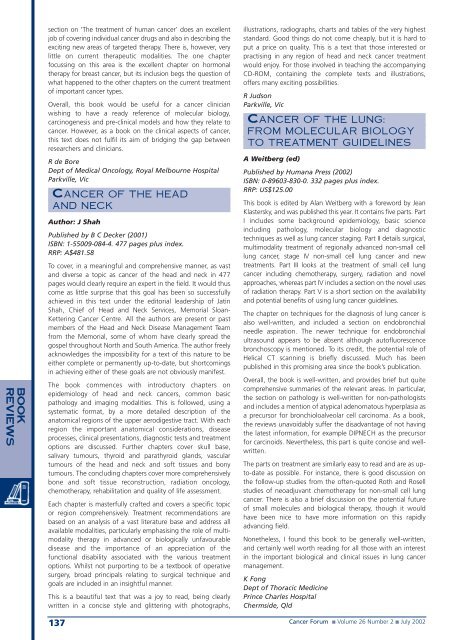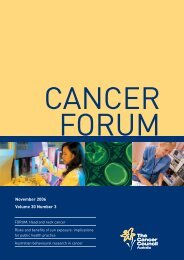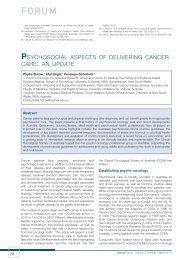Cancer Forum
Cancer Forum
Cancer Forum
- No tags were found...
Create successful ePaper yourself
Turn your PDF publications into a flip-book with our unique Google optimized e-Paper software.
ookreviewssection on ‘The treatment of human cancer’ does an excellentjob of covering individual cancer drugs and also in describing theexciting new areas of targeted therapy. There is, however, verylittle on current therapeutic modalities. The one chapterfocussing on this area is the excellent chapter on hormonaltherapy for breast cancer, but its inclusion begs the question ofwhat happened to the other chapters on the current treatmentof important cancer types.Overall, this book would be useful for a cancer clinicianwishing to have a ready reference of molecular biology,carcinogenesis and pre-clinical models and how they relate tocancer. However, as a book on the clinical aspects of cancer,this text does not fulfil its aim of bridging the gap betweenresearchers and clinicians.R de BoreDept of Medical Oncology, Royal Melbourne HospitalParkville, VicCANCER OF THE HEADAND NECKAuthor: J ShahPublished by B C Decker (2001)ISBN: 1-55009-084-4. 477 pages plus index.RRP: A$481.58To cover, in a meaningful and comprehensive manner, as vastand diverse a topic as cancer of the head and neck in 477pages would clearly require an expert in the field. It would thuscome as little surprise that this goal has been so successfullyachieved in this text under the editorial leadership of JatinShah, Chief of Head and Neck Services, Memorial Sloan-Kettering <strong>Cancer</strong> Centre. All the authors are present or pastmembers of the Head and Neck Disease Management Teamfrom the Memorial, some of whom have clearly spread thegospel throughout North and South America. The author freelyacknowledges the impossibility for a text of this nature to beeither complete or permanently up-to-date, but shortcomingsin achieving either of these goals are not obviously manifest.The book commences with introductory chapters onepidemiology of head and neck cancers, common basicpathology and imaging modalities. This is followed, using asystematic format, by a more detailed description of theanatomical regions of the upper aerodigestive tract. With eachregion the important anatomical considerations, diseaseprocesses, clinical presentations, diagnostic tests and treatmentoptions are discussed. Further chapters cover skull base,salivary tumours, thyroid and parathyroid glands, vasculartumours of the head and neck and soft tissues and bonytumours. The concluding chapters cover more comprehensivelybone and soft tissue reconstruction, radiation oncology,chemotherapy, rehabilitation and quality of life assessment.Each chapter is masterfully crafted and covers a specific topicor region comprehensively. Treatment recommendations arebased on an analysis of a vast literature base and address allavailable modalities, particularly emphasising the role of multimodalitytherapy in advanced or biologically unfavourabledisease and the importance of an appreciation of thefunctional disability associated with the various treatmentoptions. Whilst not purporting to be a textbook of operativesurgery, broad principals relating to surgical technique andgoals are included in an insightful manner.This is a beautiful text that was a joy to read, being clearlywritten in a concise style and glittering with photographs,137illustrations, radiographs, charts and tables of the very higheststandard. Good things do not come cheaply, but it is hard toput a price on quality. This is a text that those interested orpractising in any region of head and neck cancer treatmentwould enjoy. For those involved in teaching the accompanyingCD-ROM, containing the complete texts and illustrations,offers many exciting possibilities.R JudsonParkville, VicCANCER OF THE LUNG:FROM MOLECULAR BIOLOGYTO TREATMENT GUIDELINESA Weitberg (ed)Published by Humana Press (2002)ISBN: 0-89603-830-0. 332 pages plus index.RRP: US$125.00This book is edited by Alan Weitberg with a foreword by JeanKlastersky, and was published this year. It contains five parts. PartI includes some background epidemiology, basic scienceincluding pathology, molecular biology and diagnostictechniques as well as lung cancer staging. Part II details surgical,multimodality treatment of regionally advanced non-small celllung cancer, stage IV non-small cell lung cancer and newtreatments. Part III looks at the treatment of small cell lungcancer including chemotherapy, surgery, radiation and novelapproaches, whereas part IV includes a section on the novel usesof radiation therapy. Part V is a short section on the availabilityand potential benefits of using lung cancer guidelines.The chapter on techniques for the diagnosis of lung cancer isalso well-written, and included a section on endobronchialneedle aspiration. The newer technique for endobronchialultrasound appears to be absent although autofluorescencebronchoscopy is mentioned. To its credit, the potential role ofHelical CT scanning is briefly discussed. Much has beenpublished in this promising area since the book’s publication.Overall, the book is well-written, and provides brief but quitecomprehensive summaries of the relevant areas. In particular,the section on pathology is well-written for non-pathologistsand includes a mention of atypical adenomatous hyperplasia asa precursor for bronchioloalveolar cell carcinoma. As a book,the reviews unavoidably suffer the disadvantage of not havingthe latest information, for example DIPNECH as the precursorfor carcinoids. Nevertheless, this part is quite concise and wellwritten.The parts on treatment are similarly easy to read and are as upto-dateas possible. For instance, there is good discussion onthe follow-up studies from the often-quoted Roth and Rosellstudies of neoadjuvant chemotherapy for non-small cell lungcancer. There is also a brief discussion on the potential futureof small molecules and biological therapy, though it wouldhave been nice to have more information on this rapidlyadvancing field.Nonetheless, I found this book to be generally well-written,and certainly well worth reading for all those with an interestin the important biological and clinical issues in lung cancermanagement.K FongDept of Thoracic MedicinePrince Charles HospitalChermside, Qld<strong>Cancer</strong> <strong>Forum</strong> ■ Volume 26 Number 2 ■ July 2002









